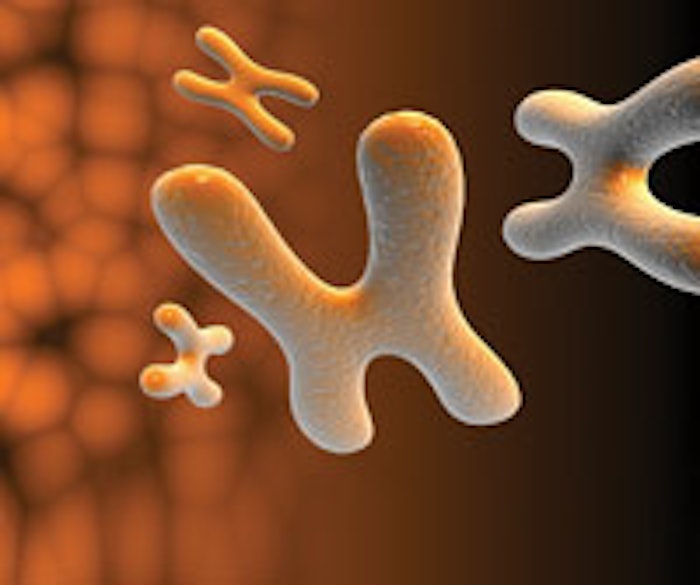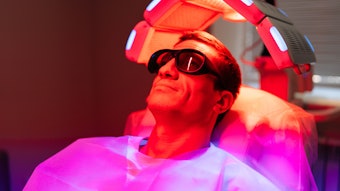
In an age of high-tech skin care, today’s clients are savvier than ever. As they have become accustomed to answers at their fingertips from smartphones and electronic devices, they expect similar convenience in other aspects of their lives, as well. These advancements may leave you wondering: How can you offer corrective skin care results with minimal downtime and without compromising the health of the skin cell? The answer can be found in telomere technology.
What are telomeres?
Each person is formed through a unique genetic makeup. This molecular blueprint—your chromosomes—is capped at the end with telomeres. Telomeres prevent chromosomes from unraveling or deteriorating, and also protect chromosomes from fusing together, avoiding malfunctioning chromosomes. A telomere is commonly compared to the protective plastic tip on the end of your shoelace due to these properties. Every time a cell divides—which is vital for new skin, blood and bone tissue reproduction—the telomere protects the DNA from losing essential gene information, but the telomere becomes shorter after each division. When it becomes too short, the cell becomes dormant, dies or may retain genetic damage that can eventually lead to mutations and cancer. Shortened telomeres have been associated with cardiovascular disease, cancer and diabetes. Longer telomeres are linked to overall healthy living and longevity.
As chromosomes lose their telomeres throughout time, this affects skin’s aging. As you age, your risk factors increase due to a weakened immune system and naturally decreased cell division. “Telomere triggers” that can limit telomere repair and create telomere erosion are found throughout daily activities. Oxidative stress and glycation play a role by damaging and inhibiting DNA, lipids and peptides within the body. UV exposure limits telomere repair and can also initiate telomere-shortening.
A common factor within these telomere triggers is inflammation. When the skin becomes irritated or traumatized, it becomes inflamed. Too much inflammation can initiate an accelerated aging process leading to premature pigmentation, elastosis, and fine lines and wrinkles. These skin conditions can be addressed through exfoliation or peels.
Exfoliation concerns
Exfoliation practices need to be considered when addressing telomere health. Skin cells can be stimulated to divide for anti-aging benefits through exfoliation. The practice of skin exfoliation has been utilized for a youthful skin appearance for generations. Exfoliation techniques have progressed significantly, particularly during the past 50 years. Chemical peels are now a standard practice in many skin care facilities. Glycolic acid, salicylic acid and retinol are commonly used to stimulate cellular turnover. However, if improperly applied, they can initiate premature aging of the skin and, through inflammation, lead to shortening of the telomere.
Skin cells have a finite amount of times they can divide before the telomere is too short for cell regeneration. Exfoliation is an excellent way to stimulate cell turnover, but within moderation. Overuse of cell-wounding ingredients in large percentage amounts or on a daily basis can overstimulate a cell to divide too quickly, therefore shortening the life of a telomere. Chemical peels should be performed in proper treatment series lengths and not year-round, according to the client’s skin type and condition, Glogau classification, and Fitzpatrick type. It is essential to skin’s health to provide anti-inflammatory and healing ingredients immediately to the skin after exfoliation to reduce any unwanted skin inflammation. There are exfoliation solutions now available that have combined anti-inflammatory ingredients into peel formulations, immediately addressing telomere aging. When addressing skin aging with telomere length, inflammation is the key component that speeds up cell division more than is needed. Too much inflammation will enable telomeres to shorten prematurely, creating unwanted aging results.
Ingredients to encourage telomere-lengthening
Utilizing a combination of ingredients can aid in the repair process and encourage telomere-lengthening. This allows for better age prevention with in-spa treatments, as well as a proper home-care system for clients. Incorporating the following ingredient categories into your skin care system is beneficial for corrective skin results.
Antioxidants. Preventing oxidation encourages healthy telomeres. This category can be utilized not only in clients’ skin care products, but also in their diets. Potent antioxidants are readily available in various forms. Choose topical products that include antioxidants with both lipid- and water-soluble structures for best results. An example is vitamin C from ascorbic acid to tetrahexyldecyl ascorbate with a water- and lipid-soluble structure, respectively.
Hydrating botanicals. Retaining a healthy barrier function will also aid in strengthening telomeres. The skin must have moisture in order to heal properly and, if inappropriately hydrated, it will remain in an irritated or traumatized state, allowing telomeres to erode. When an exfoliation treatment takes place, replenishing essential hydration back into the skin encourages it to begin repairing itself immediately. Many botanicals contain potent hydrating properties that strengthen skin’s barrier function, including shea butter, silver ear mushroom extract, rice bran oil and many others. Nightly hydration and skin repair is vital for skin’s overall health.
Peptides. Peptides are a nonirritating, nonwounding, fibroblast-stimulation ingredient. Many know peptides for their tightening effect on the skin. When used in combination with ingredients, such as alpha hydroxy acids (AHAs), they create a less inflamed environment for healthy cell turnover. Many peptides are now available in skin care products.
Plant stem cells. There are multiple plant stem cells now available in the skin care market today. They aid in DNA repair and promote healthy cell turnover. Plant stem cells can deliver potent antioxidants to the basal layer of the epidermis when formulated properly in skin care products. Plants stem cells that can be found in skin care are usually derived from the Swiss apple, grape, edelweiss, alpine rose, sea fennel, lilac, iris, echinacea, Madonna lily and, most recently, the orange.
Sun protection. UV protection is essential, because it protects against telomere erosion. Recommending a broad-spectrum SPF 30 daily moisturizer to each client is a simple daily step clients can do at any age. With the popularity of BB and CC creams, client compliance with sun protection is now easier than ever.
Telomeres and wellness
Inflammation can occur both internally and externally. As skin care professionals, encouraging clients to create healthy habits is better than suggesting they follow the latest trends. The skin is the body’s largest organ and, when cellular waste and stress are not managed properly, the body will self-regulate and manifest this process through the skin, resulting in unwanted breakouts and lesions. Four wellness points to promote within your skin care practice include the following.
1. Walk more. Depending on the client, exercise may be considered a dirty word. Encouraging walking instead of telling clients to go to the gym is usually an easier goal to make and achieve. Simple alterations to habits can make a big difference. Using the stairs once a day or parking a little farther away from the front door can initiate more exercise and promote lymph activity for easier waste removal internally.
2. Reduce stress. Every person’s stress level and limit is different. How you cope with everyday trials is an individual stress meter. Recognizing your personal stress triggers can aid in reducing or removing them from daily activities. Meditation, exercise and receiving regular spa treatments are all avenues to reduce built-up stress. These actions will help release negative tension instead of allowing it to build up in your internal systems, only to be removed through the skin.
3. Eat a balanced diet. There are more and more options for eating and dieting. As lives become more crowded and multitasking is required, eating a balanced meal can be easily overlooked. Simple suggestions to “eat fresh instead of from a box” and “consume all food groups in moderation” can be an easier guide for some clients than the extreme limitations of a diet. How many times have you lost weight only to put it back on because the diet was too limiting for your lifestyle or too challenging for your taste buds?
4. Get plenty of sleep. Every individual’s sleep-hour requirement varies. Most adults require 6–8 hours of sleep nightly. Sleep is the time when the body repairs itself. The brain is not connected to the lymphatic system to remove waste; therefore, the brain removes excess waste through cerebral spinal fluid. Because brain cells shrink up to 60% during sleep, this makes it easier for cerebral spinal fluid to flow in order to remove potential neurotoxic waste out of the brain that has accumulated throughout the day. So, when someone is making decisions and says they need to sleep on it, it’s true! Their brain needs the restorative power of sleep.
Research continues
Many studies continue to be researched and developed on telomeres. These are being processed by looking at how telomere longevity affects life span, cancer development, wound-healing and even getting gray hair. Much of this information is utilized within the skin care industry for the benefits of anti-aging skin care and wellness. Telomere technology, combined with the latest ingredients, can enable skin care professionals to offer better, more corrective results with less downtime for clients, resulting in satisfied customers and more profits.
GENERAL REFERENCES
learn.genetics.utah.edu/content/chromosomes/telomeres (Accessed Jan 28, 2014)
L Xie, H Kang, et. al., Sleep drives metabolite clearance from the adult brain, Science 342 6156 373–377 (Oct 2013)
With more than 15 years of industry experience, Tiffany A. McLauchlin, director of education for Lira Clinical, has a bachelor’s of science from the University of Utah, and is a licensed master esthetician and instructor. As a published author, McLauchlin has developed treatments, protocols, and manuals for both the professional and student.










